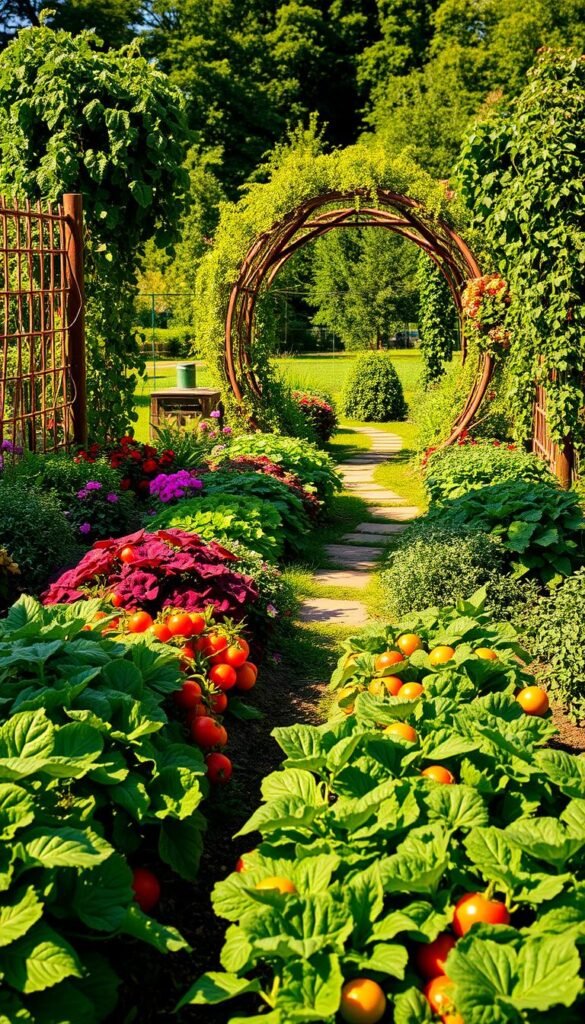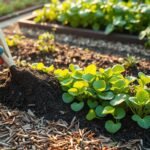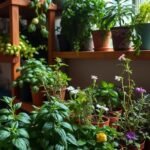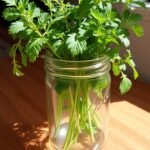Your backyard could become more than just a pretty space. With rising grocery costs and growing environmental awareness, over 80% of U.S. households now grow their own food or flowers. This isn’t just about saving money—it’s about crafting outdoor areas that nourish both your family and local ecosystems.
Imagine stepping outside to pick fresh herbs beside vibrant blooms. Edible landscapes blend colorful plants like rainbow chard or purple basil with traditional flowers, turning your garden into a living pantry. These spaces don’t just look good—they support bees, butterflies, and birds while improving soil health.
Recent studies show that tending to gardening projects reduces stress and boosts physical activity. Your plot can also help manage stormwater runoff, a growing concern in many neighborhoods. By mixing food crops with ornamental plants, you create a resilient landscape that thrives in tough weather conditions.
Ready to rethink your yard? You’ll learn how to design spaces that cut grocery bills, support wildlife, and become your favorite retreat. Let’s explore how functional beauty can grow right outside your door.
Understanding Your Garden’s Potential
Every patch of land has secrets that determine gardening success. Before planting, become a detective – your soil composition and sunlight patterns hold clues about what will thrive. Start by checking your USDA growing zone using their online map. This reveals your average frost dates and temperature ranges.
Sunlight Patterns and Soil Secrets
Track how light moves across your space through the day. Most edibles require 6+ hours of direct sun, but leafy greens tolerate shade. Use this simple test: place sticks where shadows fall at 9 AM, noon, and 3 PM. Connect them with string to map sun zones.
| Plant Type | Sun Needs | Soil Preference |
|---|---|---|
| Tomatoes | Full sun | Well-drained, pH 6-7 |
| Lettuce | Partial shade | Moist, rich organic |
| Blueberries | Full sun | Acidic (pH 4.5-5.5) |
| Mint | Variable | Most soil types |
Microclimates and Moisture Matters
Notice warmer spots near walls or low areas where water pools. These microclimates let you grow plants outside usual growing zones. Contact your county extension office for free soil tests – they’ll explain your dirt’s nutrients and texture.
Rain gauges help track precipitation. Pair this data with your sun map to plan irrigation. Even small yards can produce surprising harvests when you match plants to their ideal conditions. Remember: limitations spark creativity!
Setting Your Goals for an Edible and Beautiful Garden
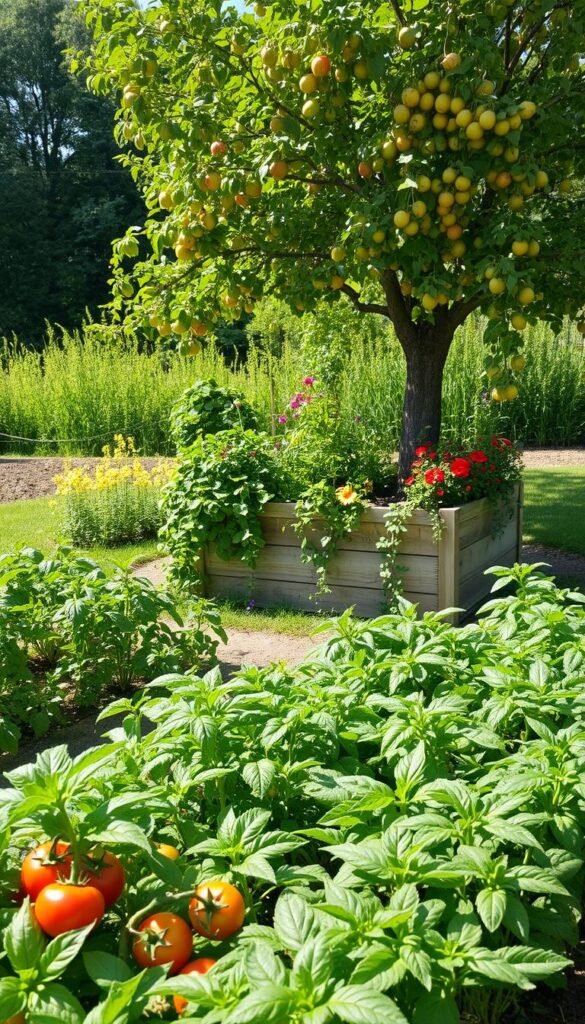
Balancing beauty and bounty starts with clear intentions for your plot. Whether you want to slash grocery bills or craft an eye-catching display, your objectives shape every planting decision. Some growers prioritize heirloom tomatoes over tulips, while others mix nasturtiums with kale for dual-purpose appeal.
Deciding on Harvest Versus Ornamental Priorities
Ask yourself: Do fresh salads or floral arrangements matter most? Food-focused spaces thrive with high-yield crops like bush beans and peppers. For visual impact, pair ruby-red Swiss chard with golden marigolds. This table shows how goals influence choices:
| Focus | Plant Choices | Maintenance | Yield |
|---|---|---|---|
| Food Production | Tomatoes, beans, zucchini | High | 25+ lbs |
| Visual Impact | Rainbow chard, lavender, artichokes | Moderate | Varied |
| Mixed Use | Basil, sunflowers, strawberries | Flexible | Dual-purpose |
Balancing Functionality with Aesthetic Appeal
Consider your available hours before selecting crops. Fast-growing radishes or perennial herbs demand less attention than fussy melons or sprawling squash. A time audit helps match plant needs with your schedule.
Plan produce quantities around your kitchen habits. Two zucchini plants might overflow a small family’s fridge, while dwarf fruit trees suit occasional bakers. Get kids excited by planting purple carrots or popcorn varieties – unexpected shapes and colors turn picky eaters into eager gardeners.
Smart landscaping merges curb appeal with practicality. Train scarlet runner beans up trellises for vertical interest, or edge flower beds with thyme. Your space can dazzle neighbors while stocking your pantry.
Creating a Vegetable Garden Aesthetic: Beautiful and Edible Landscapes
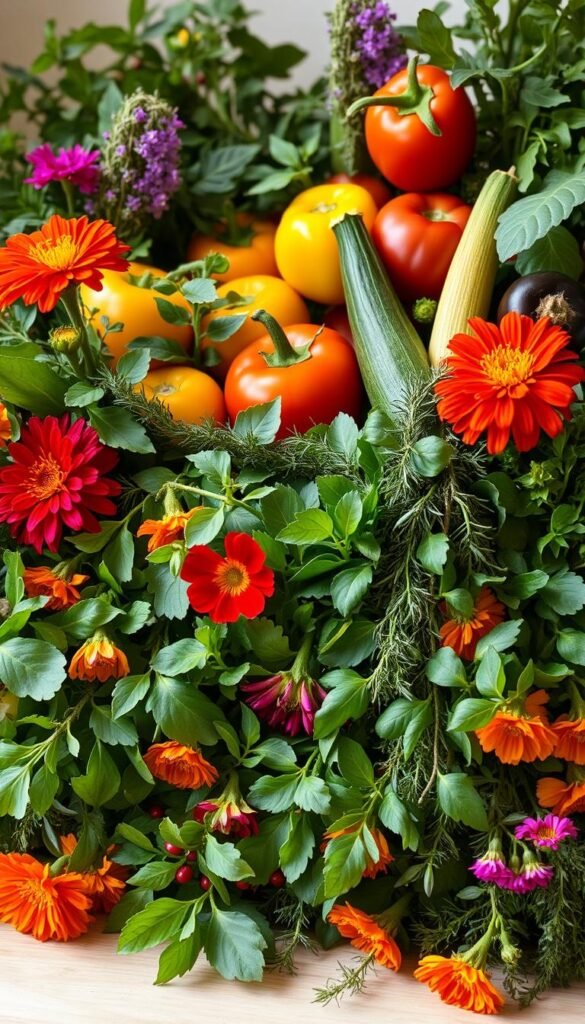
Mixing food and flora isn’t just practical—it’s a chance to reimagine your yard’s potential. Picture ruby-hued vegetables weaving through golden marigolds or frilly kale framing a rose bush. Your landscape becomes both gallery and grocery store when you treat crops as design elements.
Integrating Edible Plants with Decorative Elements
Start by pairing plants with complementary features. Red cabbage’s spiral leaves mimic roses, while rainbow chard adds painterly strokes. Tall flowers like sunflowers support climbing beans, creating living trellises. Dwarf fruit trees offer spring blossoms and autumn harvests in one compact package.
Herbs bring double duty to the table. Purple basil’s glossy leaves pop against gray stones, and thyme forms fragrant ground cover. Tuck pepper plants between zinnias—their fiery pods become natural ornaments. Even practical choices like lettuce can edge pathways with ruffled texture.
Surprise spots keep things lively. Strawberries spilling from hanging baskets or cherry tomatoes twining up porch rails add playful touches. Remember: your edible varieties should earn their place through both beauty and bounty. With smart pairings, you’ll craft spaces that nourish eyes and appetites equally.
Selecting Edible Plants and Ornamental Varieties
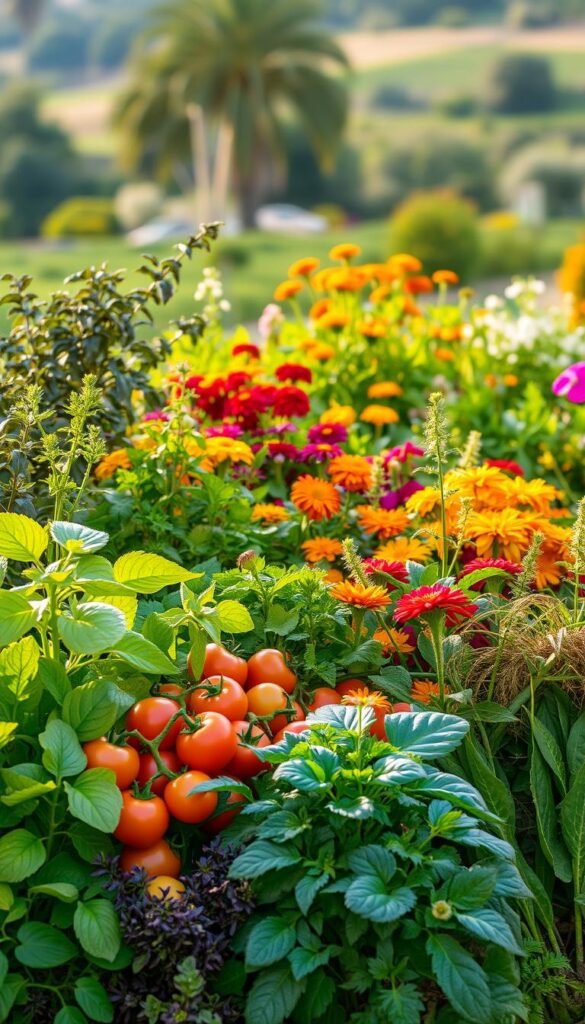
Transform your plot into a living masterpiece where every leaf and petal serves dual purposes. Strategic plant choices let you blend bold flavors with eye-catching forms, creating spaces that work overtime. Let’s uncover options that deliver both dinner plate delights and curb appeal.
Exploring Edible Flowers, Herbs, and Vegetables
Nasturtiums bring peppery zing to salads while painting beds in sunset hues. Calendula petals brighten rice dishes, and violas add whimsy to desserts. These edible plants prove that flowers can be more than just decorations.
Herbs steal the show when chosen for texture. Purple basil’s glossy leaves contrast with silvery sage, while garlic’s curling scapes create sculptural interest. Rosemary’s upright growth works as a fragrant hedge, and thyme spills beautifully over rock walls.
Don’t overlook showstopper vegetables. Rainbow chard’s neon stems glow against dark mulch, and dinosaur kale’s crinkled leaves add drama. Scarlet runner beans climb arbors with fiery blooms that hummingbirds adore.
Choosing Perennials, Shrubs, and Fruit Trees
Blueberry bushes offer three seasons of interest: spring blossoms, summer berries, and fiery fall foliage. Elderberries produce creamy flower clusters followed by dark fruit, while serviceberries provide early spring blooms and bird-friendly berries.
Dwarf apple trees fit small yards yet yield full-sized harvests. Pair them with hazelnut shrubs for layered canopies. Perennial plants like artichokes return yearly with architectural silver leaves and tasty buds.
Match varieties to your climate for success. Citrus thrives in warm zones, while sea buckthorn handles chilly winters. Your local nursery can recommend options that flourish in your soil and light conditions.
Design Principles for a Harmonious Edible Landscape
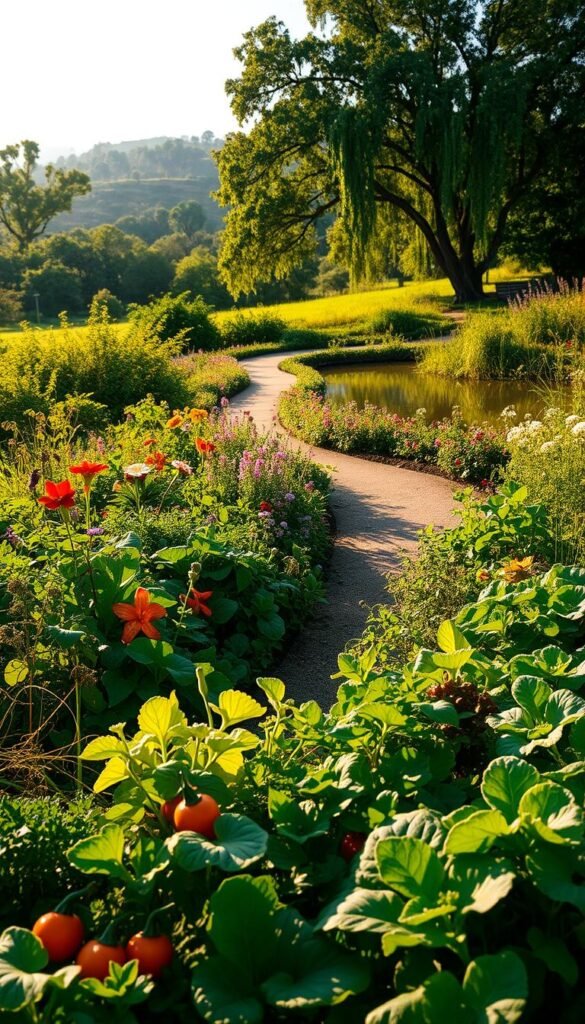
Crafting an eye-catching edible space requires more than just tossing seeds in soil—it’s about thoughtful design that marries form and function. Strategic plant placement transforms your plot into a living tapestry where every element works together. Let’s explore how to layer colors, textures, and heights for maximum impact.
Using Color, Texture, and Height for Visual Impact
Start by playing with color relationships. Pair deep purple basil with golden marigolds for bold contrast, or mix red lettuce varieties with white alyssum flowers. Cool-toned plants like blue kale create calming backdrops for vibrant nasturtium blooms.
Texture adds depth to your landscape. Combine velvety sage leaves with spiky garlic scapes, or let feathery dill fronds soften squash’s broad foliage. Ground covers like creeping thyme create living carpets between taller specimens.
Height variations guide the eye through your space. Layer strawberries at ground level, bush beans at knee height, and pole beans climbing up sunflower stalks. This vertical stacking maximizes growing space while creating natural shade for shade-tolerant crops.
Plan for year-round appeal by selecting plants with staggered bloom times. Early spring violets give way to summer’s zinnias, followed by autumn’s ornamental peppers. This approach sustains pollinators while keeping your landscape lively through seasons.
Smart design also boosts pest resistance. Interspersing marigolds with tomatoes deters nematodes, while fragrant herbs confuse insects seeking favorite crops. Your edible oasis becomes both beautiful and resilient through intentional arrangement.
Planning and Mapping Your Garden Layout
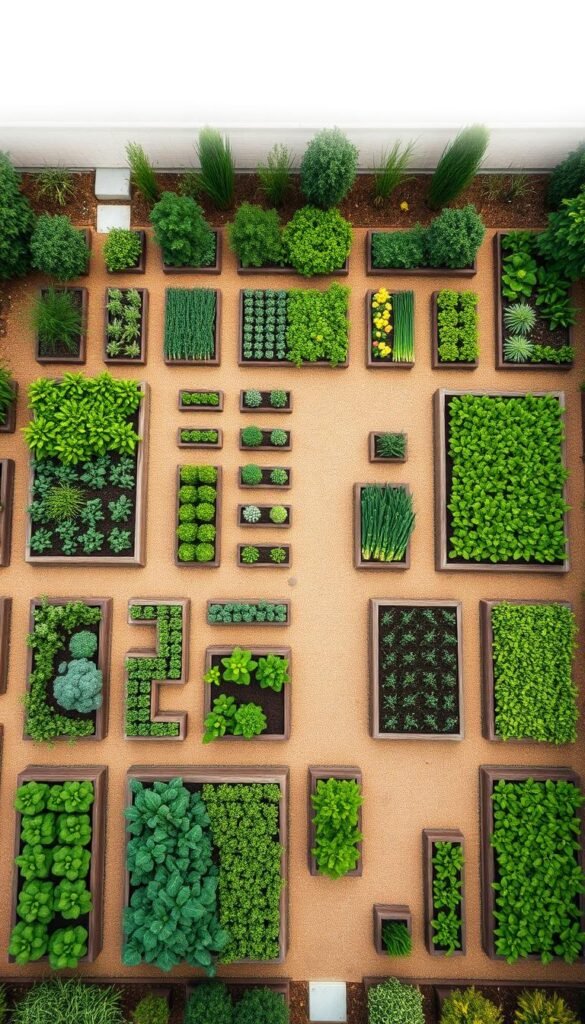
Designing your outdoor space begins with a pencil and paper, not a shovel. Start by dividing your garden into zones based on sunlight exposure and plant needs. Cool-weather crops like spinach might claim shadier corners, while sun-worshipping peppers get prime real estate near the south-facing edge.
Sketching Your Garden Zones and Plant Blocks
Block planting beats traditional rows for space efficiency. Group four square feet of the same plant together—this creates living mulch that suppresses weeds. Imagine alternating blocks of ruby lettuce with golden marigolds for pest control and visual pop.
Pathways matter more than you think. Keep them 18-24 inches wide for comfortable harvesting access. Curved walkways add whimsy while directing foot traffic away from delicate roots. Use gravel or wood chips to define these routes without stealing room from growing areas.
Your sketch should account for future changes. Leave empty beds for succession planting later in the season. Tall crops like corn go on the north side to avoid shading shorter plants. This forward-thinking approach lets your landscaping evolve with your needs.
Smart spacing isn’t just about plant health—it makes watering and weeding easier. Follow seed packet recommendations, but don’t fear creative adjustments. Bush beans might snuggle closer if paired with vertical cucumbers. Your garden becomes a living puzzle where every piece fits perfectly.
Maximizing Space with Vertical and Block Planting Techniques
Unlock your plot’s full potential by reaching upward and planting smarter. Vertical structures and strategic spacing let you grow more food without expanding your footprint. This approach works wonders in urban yards or small plots where every inch counts.
Reach New Heights with Smart Supports
Train climbing plants like pole beans or cucumbers onto trellises and stakes. These living walls create shade for cool-weather crops below. Try an A-frame structure with melons growing up top and spinach thriving underneath.
Choose compact varieties that excel in vertical systems. Snap peas and miniature squash save space while producing full-sized harvests. Even tomatoes perform better when staked – their fruits stay cleaner and ripen faster.
Dense Planting for Maximum Yield
Forget perfect rows. Scatter seeds across blocks, then thin seedlings as they grow. Leafy greens and root crops tolerate tight spacing better than most packets suggest. This method reduces weeding and creates natural mulch through overlapping leaves.
| Crop Type | Recommended Spacing | Block Planting Spacing |
|---|---|---|
| Lettuce | 12″ apart | 6-8″ apart |
| Radishes | 2″ apart | 1″ apart |
| Bush Beans | 4″ apart | 3″ apart |
Fill gaps between larger plants with creeping thyme or alpine strawberries. These ground cover options suppress weeds while adding edible interest. Rotate crops quickly in these dense beds – harvest baby greens, then replant with fast-growing herbs.
Succession planting keeps your garden productive all season. After pulling spring carrots, immediately sow bush beans in the same space. With smart layering and timing, you’ll triple your harvest from the same square footage.
Cultivating Sustainability and Garden Health
A thriving plot does more than feed your family—it strengthens your local ecosystem. Smart practices protect your soil and plants while reducing maintenance time. Let’s explore how to keep your space productive and planet-friendly.
Natural Pest Control and Soil Amendments
Companion planting works wonders. Marigolds deter nematodes near tomatoes, while basil repels flies from peppers. For persistent issues, try neem oil sprays—they stop pests without harming bees.
Enrich earth naturally with compost or worm castings. These additions boost nutrients better than synthetic fertilizers. Always test treatments on a few leaves first when using near edibles.
Implementing Watering and Irrigation Strategies
Drip systems deliver moisture directly to roots, cutting waste by 50%. Mulch with straw or shredded leaves to lock in hydration. Your garden stays lush even during dry spells.
Collect rainwater in barrels for chemical-free hydration. Morning watering prevents fungal growth, letting leaves dry before nightfall. These simple shifts make gardening easier while conserving resources.
By nurturing your soil and choosing eco-friendly methods, you’ll grow food that’s safer and tastier. Your efforts create a habitat where plants and pollinators thrive together—a true win for your garden and the planet.
